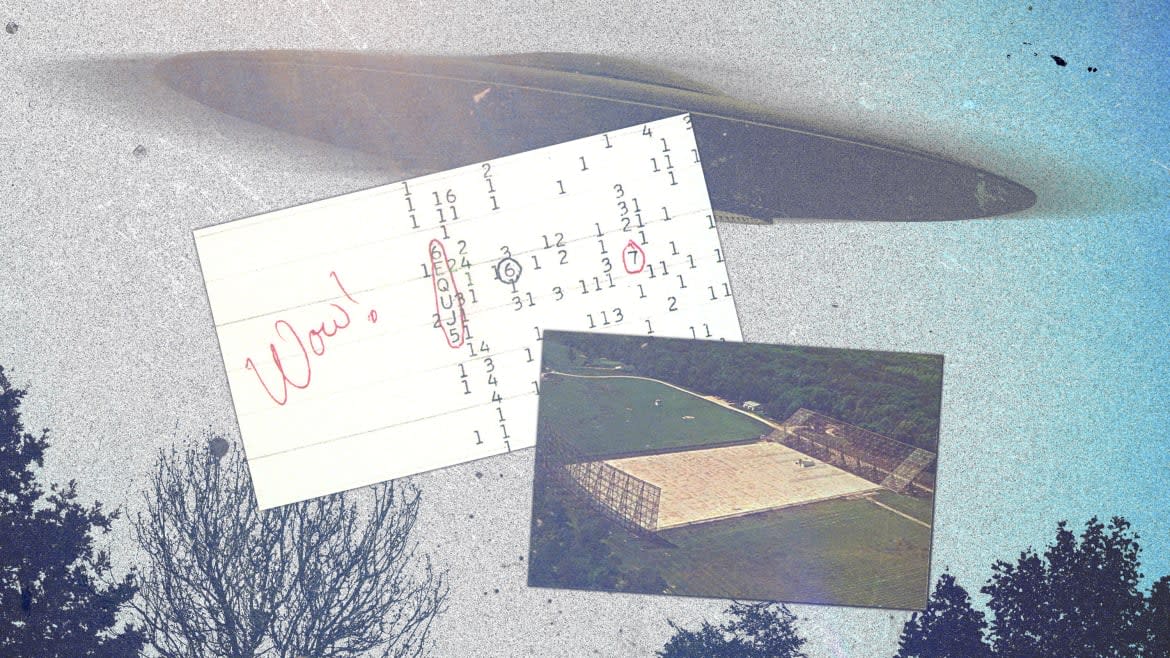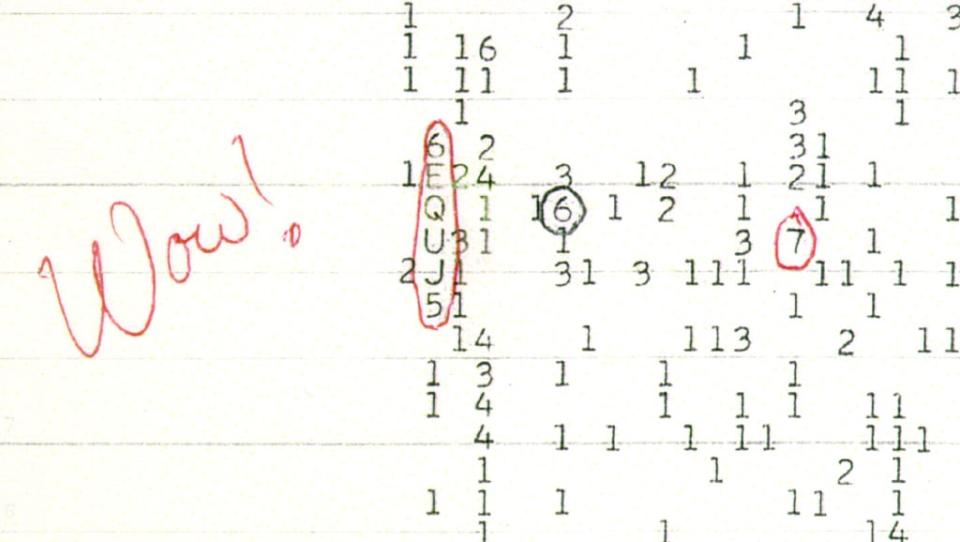Why There’s a Chance We Heard From Aliens Back in 1977

On Aug. 15, 1977, an astronomer at Ohio State University, listening to the galaxy with the university’s powerful Big Ear radio telescope, overheard alien chatter echoing somewhere out there in the direction of the Sagittarius constellation.
Well, maybe. When Jerry Ehman noticed the highly structured, seemingly deliberate signal in a computer printout of radio data, he jotted down a note: “Wow!” His exclamation gave the discovery its name.
The Wow! signal seemed like it might have originated from an extraterrestrial civilization. After all, the two-and-a-half-minute signal was loud—a full 30 times louder than the background noise of space.
But scientists were never able to pick up the signal a second time. Lacking additional data, they assumed the signal was just random noise from some star or comet or other natural source–and eventually moved on.
Wow! faded into history—just another possible near-miss in our search for alien life alongside one very interesting Martian soil sample from 1976, as well as the mysterious object known as ‘Oumuamua that blazed through our solar system back in 2017.
Our Efforts to Find Alien Life Have Gone Nowhere. This New Strategy Could Change That.
Now a team led by Columbia University astronomer David Kipping is making the case for a fresh effort to detect the signal. We should be able to find it—or confirm it’s gone for good—with just two additional months of hard work and some creative thinking, Kipping and his co-author, Chicago data consultant Robert Gray, wrote in their peer-reviewed study, which appeared online on June 22 and has been accepted for future publication in the science journal Monthly Notices of the Royal Astronomical Society.
“I think it’s worth chasing down for a couple more months to get to the point where we could say with confidence that the field isn’t worth pursuing anymore,” Kipping told The Daily Beast. “Either we spend two months on the Wow! field and see nothing and can then move on, or we see a recurrence—and that would change the whole story.”
Ehman was working as a volunteer for the then-new field of science known as the Search for Extraterrestrial Intelligence program, or SETI, when he first noticed the Wow! signal 45 years ago. Besides how loud he noticed it came across in the readout, Ehman also saw that it traveled along a seemingly symbolic frequency: 1420 megahertz, the resonant frequency of an energized hydrogen atom.

The original printout of the Wow! signal with Jerry Ehman’s handwritten exclamation.
The frequency and loudness made Wow! “arguably the most compelling SETI signal ever found,” Kipping and Gray wrote.
SETI’s methods for finding signs of life—listening for radio signals, looking for lasers or other visual evidence of aliens—have evolved a lot since the effort got underway back in the 1960s. The field’s standards for what might qualify as evidence of aliens have also changed.
But one key criterion remains the same: repeatability. It’s not enough to overhear an artificially produced signal once. After all, intelligent beings, if they’re trying to communicate with each other or us, wouldn’t broadcast just one message once, right? They’d probably try again and again, most likely on a regular schedule.
That’s where the Wow! discovery went wrong all those decades ago. Periodically for decades, astronomers tried listening for a similar signal—most recently in 2020 and 2002. They pointed radio telescopes at Sagittarius, tuned them to 1420 megahertz… and waited.
They heard nothing, despite admirable patience. In 2002, astronomers listened for 14 hours at a time across six different observation periods, and still registered nothing but the usual groan of background radiation.
That seems to imply that the 1977 signal was some kind of fluke—a random burst of galactic noise. “Lack of any repetition (especially with greater sensitivity, longer observations and broader spectral coverage), ostensibly places considerable pressure on the credibility of the Wow! signal,” Kipping and Gray wrote.
But maybe it’s our expectations that are off. “In order to learn, scientists must admit that their knowledge is incomplete,” Avi Loeb, a Harvard astronomer, told The Daily Beast.
Maybe Wow! really was an alien signal, but the beings who broadcast it didn’t honor our insistence that they communicate a certain way. In their study, Kipping and Gray proposed two possibilities in the event Wow! did come from E.T. “It could either be a non-continuous emission source and/or a continuous source that drifts in frequency.”
In other words, maybe the Wow! signal repeats, but it doesn’t repeat quickly or at predictable intervals. Maybe it’s sliding up and down in frequency.

David Kipping.
If we abandon old, rigid assumptions about how aliens could communicate, we might stand a better chance of hearing Wow! again. Sixty-two days of close listening with the latest radio receivers should be enough to find—or rule out yet again—an erratic alien signal, Kipping and Gray estimated.
There are problems with the proposal. What if the signal repeats erratically, but at an interval of decades or even centuries—making it extremely unlikely we’d overhear it? “It does seem as if people are changing the possible parameters of the signal to fit one detection and a lot of negative results,” Seth Shostak, an astronomer with the California-based SETI Institute, told The Daily Beast.
Another problem, of course, is the millions of dollars a fresh, two-month search for Wow! would cost. “Extraordinary evidence requires extraordinary funding,” Loeb quipped. After so many fruitless surveys, Shostak for one predicted the committees that assign telescope time would turn down a request for another Wow! search.
Let’s assume one team of SETI scientists or another secures the funding, gets access to a radio telescope, applies Kipping and Gray’s new standards and—eureka!—hears the 1977 signal once again.
The Mystery Behind a Nearby Alien Beacon Is Solved
Even that wouldn’t be hard proof of aliens, Kipping stressed. It’s just one step toward possibly, eventually proving aliens exist. We’d need a lot more data before we announced we’re not alone in the universe.
But discovering Wow! a second time could help us tune into the same signal a third, fourth, fifth time, and so on. “It would mean the signal could be re-observed in the future,” Kipping said. The longer we listen, the more we might learn. “That information could uncover some new natural radio source never seen before, or even a message from another civilization.”
It all starts with opening our minds to the possibility that aliens, if they’re out there, don’t necessarily think—or talk—the way we do.
Get the Daily Beast's biggest scoops and scandals delivered right to your inbox. Sign up now.
Stay informed and gain unlimited access to the Daily Beast's unmatched reporting. Subscribe now.

